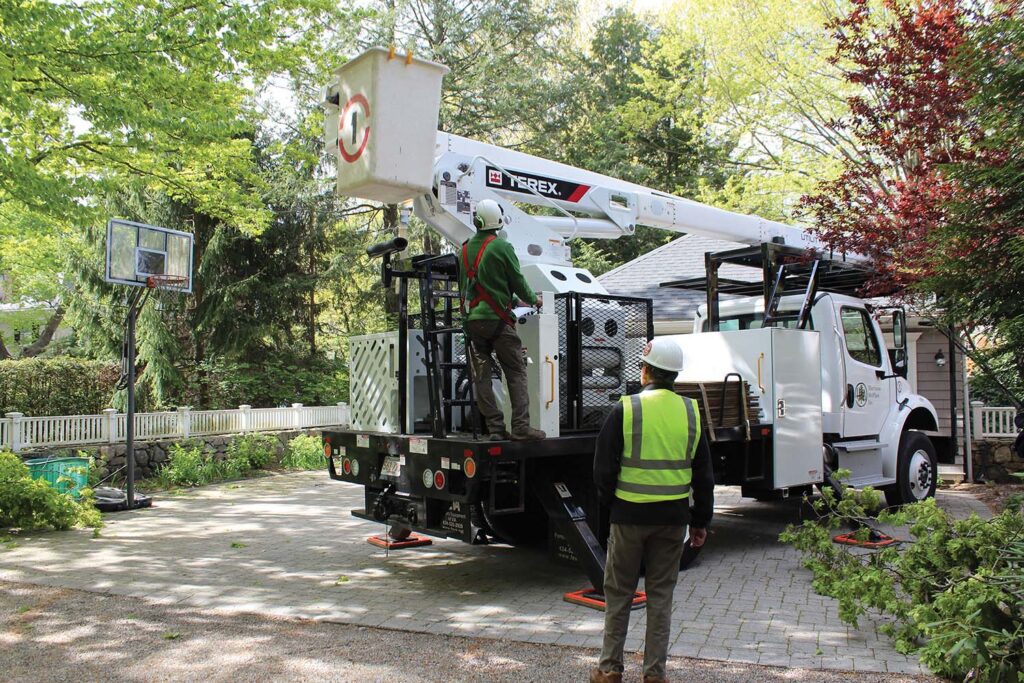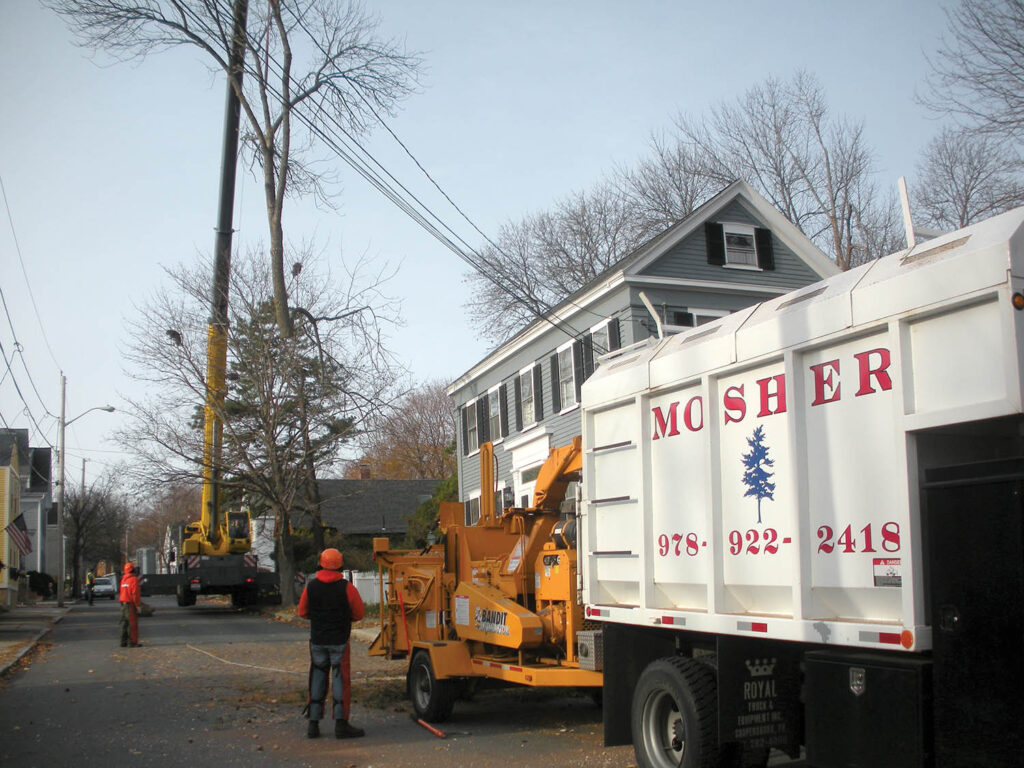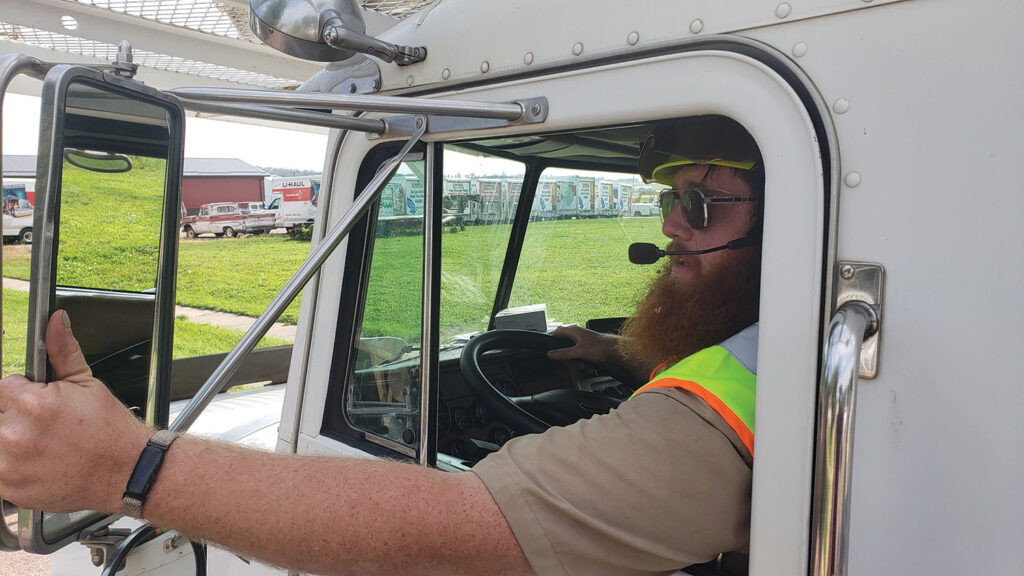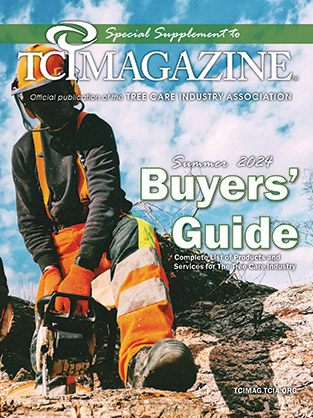Driver Training Should Be High Priority
An aspect of arboricultural operations that is given little attention is driving. But the trees do not come to us, we go to them. This means a lot of time in a truck. While driving incidents are not a leading cause of tree-worker fatal injuries, they do account for many nonfatal injuries.

The heavier weight of our trucks combined with speeding means the impact force on the car in a collision is very high. The car and its occupants are the losers. TCIA file photo.
Furthermore, driving incidents often – and tragically – involve the public and their property. You do not need to search long to find incidents where
aerial-lift trucks have ended up in buildings rather than next to trees.
Moving-vehicle incidents are included in the Occupational Safety and Health Administration (OSHA) catastrophe and fatality investigation database. But a more complete census for fatal incidents involving motor vehicles traveling on public roads is maintained by the National Highway Traffic Safety Administration (NHTSA) through their Fatality Analysis Reporting System (FARS). The NHTSA also tracks nonfatal injuries and property damage accessing a sampling of police reports through the Crash Report Sampling System (CRSS).
A large truck is defined as a vehicle with a gross vehicle weight rating (GVWR) greater than 10,000 pounds. There were about 750 drivers of these trucks killed in crashes across all industries in 2022, according to FARS. Another 60,000 crashes involving nonfatal injuries and more than 400,000 incidents with only property damage were estimated from CRSS data. The tree care/landscape-
services industry accounts for a little more than 3% of these incidents.
Driver-related accidents
Driver-related factors are involved in about half of all fatal truck collisions. The most frequent driver-related factor in moving-vehicle fatal incidents is speeding, followed by impairments and distractions. While this data is for all industries and not specific to the tree care/landscape-services industry, there is probably a similar trend.
Speeding is the most common driver-related factor in vehicle collisions, regardless of whether the driver is operating a car or a commercial truck. It is a driver-related factor in a quarter of all large-truck collisions. It is hard to keep on schedule, and truck drivers are pressed to make up lost time. When a sales arborist calculates the time to complete a job, it’s an estimate, and sometimes the work takes longer. Crews are sometimes in a rush to get to the next job or back to the shop at the end of the day. But arriving late is better than not arriving at all.
Sometimes we arrive, but not the occupants in the other vehicle involved in the collision. The majority of fatalities in truck collisions are not the truck drivers but occupants in the cars that are struck. Not only does speeding reduce reaction time, the heavier weight of our trucks combined with speeding means the impact force on the car in a collision is very high. The car and its occupants are the losers.
Alcohol
The most common driver impairment is driving under the influence of alcohol, drugs or medication. These account for almost another quarter of the driver-related factors in moving-vehicle fatal incidents. Alcohol is involved in many of these incidents, such as a recent one where an aerial-lift truck left the road and, ironically, struck a tree. Fortunately, the tree was the only casualty, but the driver had a blood alcohol content of 0.15%.
Sometimes alcohol and drugs are combined. One driver of a chip truck struck a car, killing all its passengers. He had been taking pain medication prescribed to another worker and had washed it down with a beer.

While the new hire may have the appropriate CDL, do they have the skill to drive an aerial lift with a full chip box while towing a chipper, and in heavy traffic? TCIA file photo.
Distractions
About another quarter of driver-related factors in moving-vehicle fatal incidents are distractions. One of the most common distractions is a cell phone. The most common cellphone distraction is not reaching for the phone or tapping, but talking on it. Just talking on a cell phone – even hands-free – while driving increases crash risk.
Distractions are constant while driving on urban-area roadways. Streets are lined with flashing signs and the ubiquitous (and annoying) waving tube guys. All this activity has a strong effect on a driver’s attention. The movement of these signs and objects captures visual attention – that is their purpose – but they can hold a driver’s gaze longer and more often.
Qualifying drivers
It is assumed, incorrectly, that the state has all the responsibility for qualifying drivers. After all, they provided the driver’s license and have the means to revoke it. But this is a minimum standard. Greater than 90% of moving-vehicle fatal incidents occur with drivers who are licensed to operate the class of vehicle in the incident. It is the responsibly of each company to qualify their drivers.
The requirements for a commercial driver’s license (CDL) have become more stringent. The Federal Motor Carrier Safety Administration (FMCSA) now requires classroom training and documented, supervised driving time, among other requirements, to obtain a CDL. These requirements have increased the cost to a company for assisting their workers in obtaining a CDL. Unless the company has an internal trainer, there is now the cost – often $3,000 or more – for classroom instruction by a training company. There also is the cost of lost production while having an employee attending a class rather than doing tree work.
This also has made holding a CDL a valuable credential. This means retention of employees with the appropriate CDLs is critical. This is especially important if they have the skills to drive with trailers and a truck with a standard transmission. While many newer trucks have automatic transmissions, there are still a lot of companies with a fleet of trucks with standard, or manual, transmissions.
It is becoming increasingly difficult to find workers who are proficient in driving these trucks. A recent incident involved a driver who had only driven a standard a few times. The truck and trailer were parked on a slight incline. When he tried to engage the clutch, the truck and chipper rolled back and struck a co-worker, pinning him against another vehicle.
Road tests
Companies routinely check driving records of candidates as part of the hiring process. This helps, but only about 7% of moving-vehicle fatal collisions happened to a driver with a previous moving violation. Even if the driving record is clean, are they familiar with the driving requirements of the job? While the new hire may have the appropriate CDL, do they have the skill to drive an aerial lift with a full chip box while towing a chipper, and in heavy traffic?
Conduct a road test for any new hire to be sure of their skills for driving the company vehicles that may be assigned to them. A road test should be repeated every year. Have a supervisor drive with each truck driver once during a year. Just a ride-along for a few hours. This can highlight any skill deficiencies. Are they pulling past stop signs to stop? Are they changing lanes in an intersection? Intersections are hazardous, and other drivers may not be expecting a lane change in this zone. What about turning too fast? This could cause the chipper to veer into the other lane.

Use a spotter when backing up to reduce property damage and prevent crew
injuries. Every year a tree-company truck backs over a worker fueling a chain saw. Photo is of Cody Thompson, courtesy of Glacial Lakes Tree Service.
Driver training
Despite these occurrences, many tree companies, especially the small one- or two-crew tree companies, give little thought to driver training. Any aspect of the business that is not discussed or covered in training is likely to be ignored by the crew members. If the company does not put any importance on it, why should the workers?
Defensive driving should be the topic of tailgate sessions at least several times a year. Many companies will cover aerial-
device, chain-saw and chipper safety, as examples, but motor-vehicle safety is neglected. Driver education should be part of an annual safety-training event. But not just as a PowerPoint presentation. Go out into a parking lot, set up a course with cones and have several drivers compete to see who can back through the course with a truck and a trailer. Nothing tree workers like more than a little competition!
Companies should have a written driver-safety program. Be sure it includes a mobile-electronic-device policy. Drivers should not use their cell phones – remember, even hands-free use is a distraction. Enforce rules related to riding in (and on) company vehicles. Seat belts are required. No jumping on or off trucks or trailers.
Drivers also have a responsibility for safety. Always conduct a pre- and post-trip inspection of the vehicle. It only takes a few minutes, and better to catch problems at the shop than down the road. This is also a time to check that everything is properly cradled and hitched before leaving in the morning.
Closing tips
While driving during the day, use care in changing lanes. Anticipate the need to switch lanes as far out as possible – sudden lane switches are where most incidents occur. Better to miss your turn and have to double back than make a sudden lane change. Always check the mirror, and signal before beginning to move. If towing a chipper or trailer, make sure there is adequate space for it to follow when changing lanes.
Make wide right turns when towing a chipper or trailer. If you cut the corner too tightly, the chipper may bump the curb or, far worse, strike a pole or person. Bicycles, scooters and even motorcycles may squeeze between the truck and the curb – often in your blind spot – unaware that they are in your turning space.
Use care when approaching or entering intersections. Many of our moving-vehicle incidents occur at intersections. Slowing slightly when approaching an urban intersection provides more time to react when a car tries to beat a red light. They forget the weight of our vehicles and trailers. Stopping distances are longer.
Use a spotter when backing up. This will reduce property damage. It also can prevent crew injuries. Every year a tree-company truck backs over a worker fueling a chain saw.
Finally, while it is the most basic safety rule, wear the vehicle’s restraint system. It, like all our PPE, is our last layer of protection. It only becomes important when everything else has gone wrong. Drivers not using the restraint system at the time of the collision are five times more likely to die. It can make the difference between life and death in an incident.
John Ball, Ph.D., BCMA, CTSP, A-NREMT (Advanced-National Registry of Emergency Medical Technicians), is a professor of forestry at South Dakota State University.




